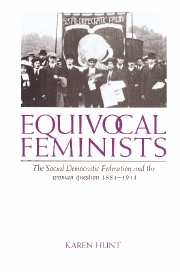Book contents
- Frontmatter
- Contents
- Acknowledgements
- Introduction
- Part 1 The woman question: the theory
- Part 2 The SDF and the woman question: the theory and practice of the party on aspects of the woman question
- 4 The politics of the private sphere
- 5 Women and work
- 6 The suffrage
- Part 3 Women and the SDF: the practical implications of the SDF's understanding of the woman question
- Conclusion
- Appendices
- Bibliography
- Index
4 - The politics of the private sphere
Published online by Cambridge University Press: 14 January 2010
- Frontmatter
- Contents
- Acknowledgements
- Introduction
- Part 1 The woman question: the theory
- Part 2 The SDF and the woman question: the theory and practice of the party on aspects of the woman question
- 4 The politics of the private sphere
- 5 Women and work
- 6 The suffrage
- Part 3 Women and the SDF: the practical implications of the SDF's understanding of the woman question
- Conclusion
- Appendices
- Bibliography
- Index
Summary
The dividing line between the ‘public’ and ‘private’ was of crucial importance for the SDF's analysis of the woman question. The division marked the limit of political activity, although it was a distinction that was both historically and culturally specific. The private sphere of the family, personal relationships and individual conscience provided an inner sanctum which was supposedly free from political dispute. This masculine model of politics was least satisfactory when confronted with elements of the private sphere which had, even temporarily, entered the public domain. Given the party's reliance on such a clear distinction between public and private, the ways in which issues denned as ‘private’ were perceived by SDFers, and the means by which these issues penetrated the public sphere, need to be examined more closely. This chapter, therefore, examines several aspects of the so-called private sphere – the family, marriage and ‘free love’ – and the conditions under which SDFers discussed them.
Socialism and the family
The family is often taken to be a symbol for the whole private sphere. The paradoxical way in which the SDF perceived the family was characteristic of other contemporary socialist organisations. Although socialists as a whole were publicly identified with the abolition of the family, individually they not only relied heavily on support from their families but also used positive familial images as part of the language of socialism.
By the time the SDF was founded, socialism and communism already had established certain characteristics in the public mind.
- Type
- Chapter
- Information
- Equivocal FeministsThe Social Democratic Federation and the Woman Question 1884–1911, pp. 81 - 117Publisher: Cambridge University PressPrint publication year: 1996
- 1
- Cited by

